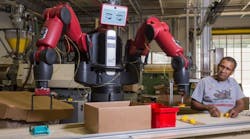To meet productivity and efficiency demands, industries are rapidly turning to automation. But automation systems are expensive.
A highly underutilized government incentive, the Research & Development (R&D) Tax Credit, help offset much of the development and implementation costs for automation systems and provide a source of capital for the acquisition of additional technical talent.
The Evolution of the Tax Credit
In the late 1980s, the U.S. took steps to battle an economic slowdown by implementing the R&D Tax Credit to encourage domestic corporate innovation. And in the decades since its inception, the requirements surrounding the credit have evolved to the overall benefit of U.S. businesses.
When first introduced, the language defined by the incentive specified that to qualify for a tax credit, all research and development had to be “new to the world.” This verbiage was later amended and is now much more beneficial to companies whose actions are naturally innovative. Today, the credit is our government’s primary incentive to reward businesses for driving industry progress and for keeping technical jobs on U.S. shores.
Real-World Industry Applications
Due to the custom and highly technical nature of automation and robotics, companies that implement these systems have historically been prime candidates for the credit. Industries like food processing, automotive, technology, logistics, agriculture and equipment suppliers have all grown exponentially over the last decade thanks to automation. During my time working as a consultant who specializes in the credit, I have seen a large number of companies that implemented automation systems receive substantial value from this incentive.
Activities that qualify, but are not limited to, include:
- Designing custom automation machinery and robotics for both discrete and process manufacturing operations
- Implementation of automated systems such as PLC, HMI, Information Systems, motion/process control, robotics, RFID, and 3D laser scanning
- Streamlining and analyzing data acquisition through visualization technology and instrumentation
- Controlling field and factory operations remotely using mobile instrumentation, virtualization and industrial wireless networks
- Simplifying control sequences and improving efficiency through systems integration
Real-World Examples
For instance, a relatively small manufacturing company was able to claim over $70,000 in federal credits by undertaking a project to expand their alloy cutting capabilities, since they had been forced to decline past projects as they did not possess the requisite equipment.
During the project, the company determined that integrating a laser cutter would enhance their fabrication capabilities and increase their ability to contract customers in a wider range of specialized industries. After electing to implement an automated laser cutting system, the company determined that a corresponding 12-shelf tower would reliably sustain the volume of material necessary for the automation.
Another example is a products development company that claimed roughly $245,000 in federal credits by undertaking various qualifying projects to help manufacturers meet governmental requirements. Among other qualifying projects, they developed a dust collection system for an aluminum manufacturer that required specialty explosion-handling capabilities.
Finally, a meat processor’s project entailed the development of a large processing line, including 30 pieces of equipment. The company was contracted to retrofit several existing rooms and systems, providing all programming, equipment, automation, and material handling, while upgrading and customizing to provide optimal performance. Multiple iterations were developed to meet all project parameters as well as a custom system dealing with high viscosity brine, and a highly unique set of tanks made to deal with a protein application; each requiring very high polishing, control, measurement, and temperature controls. This meat processor was able to claim $540,000 in federal credits for its efforts.
Unfortunately, even though most businesses that implement automation systems are eligible for the credit, only about 5% actually take the time to go through the process of claiming it. This is why any business owner seeking an edge over the competition and different avenues for capital is strongly encouraged to speak with their tax professional about what government incentives they are either potentially overlooking or not utilizing to the fullest.
Greg Knarr joined alliantgroup in 2010 as a Director based out of Indianapolis and represents much of the company’s Midwest territory. Greg is an expert on the Research and Development (R&D) Tax Credit, and the role that automation plays in alliantgroup’s mission to strengthen U.S. businesses by helping to reduce tax liability.




